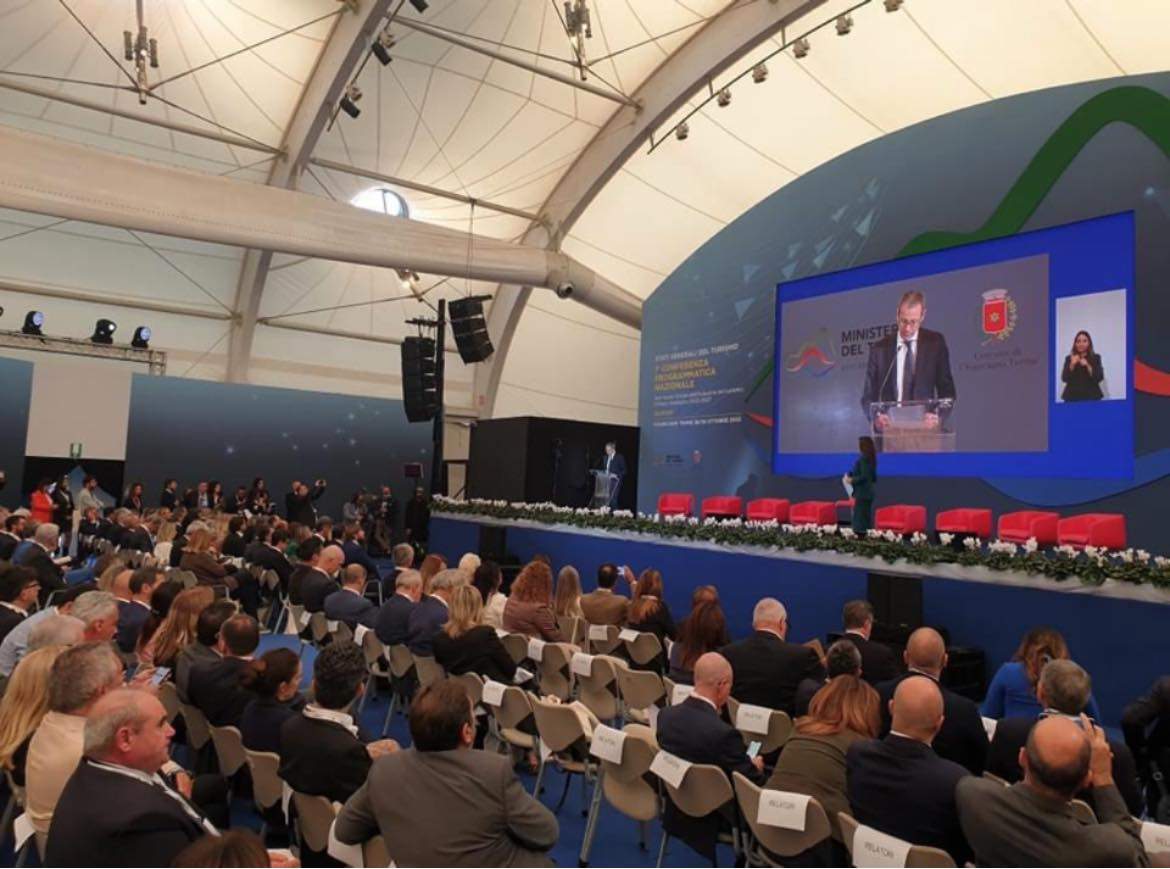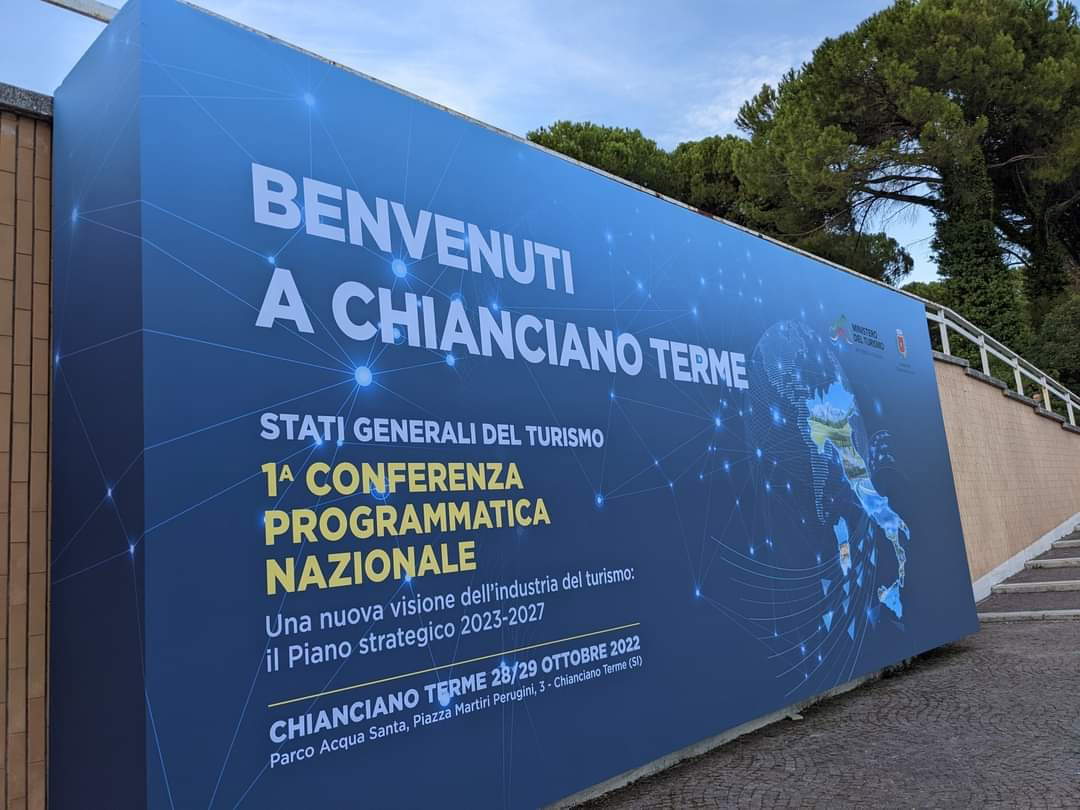On Oct. 28 and 29, the Acquasanta Park in Chianciano Terme hosted the Stati Generali del Turismo (States General of Tourism), the first national planning conference on the subject organized by the Ministry of Tourism and during which the foundations will be laid for the Strategic Tourism Plan 2023-2027 (STP). The event, with a rich program, is promoted by the Ministry in collaboration with the Municipality of Chianciano Terme and major players in the sector as well as, among others, Enit, Trenitalia, Federalberghi and Confturismo. Two days in which the debate focused on the crucial points of the development of the tourism sector: from the analysis of the national and international post-pandemic context, to the point on governance and training, from food and wine tourism to listening to the main stakeholders.
After two really complicated years and the emergence of an autonomous Ministry of Tourism, a fresh start is being tried: in 2022 many tourists returned, almost approaching 2019 levels even though at the same time other emergencies such as war and the raising of all prices have arrived. The initiative is the first action in the process of developing and adopting the Tourism Strategic Plan 2023-2027 to define the future strategy for the next five years. It is an appointment that aims to foster an open discussion with industry players, from regions to stakeholders and trade associations, for full and total involvement in the definition of short- and medium-term measures.
During the event, the guidelines of the Pst, which will be developed through five strategic pillars: sustainability, innovation, quality and inclusion, training and governance, were presented. The in-depth discussion dedicated to food and wine tourism was also well attended. The two-day event was opened by a message from newly appointed Minister Daniela Santanchè, who started by stressing, “My non-attendance is due not only to my desire to first want to delve into the numerous dossiers within the Ministry’s competence but, it is also meant to be a sign of respect for the work done to date by those who preceded me and who wanted this event,” namely Massimo Garavaglia, who was not reappointed as Minister and who conceived the event. “The expectations of the tourism industry operators towards the government,” said Santanchè, “for the coming years are rightly very high, especially after the damage caused by the pandemic and the current serious international political and energy crisis. The tourism sector accounts for about 15 percent of our GDP and is in the top ranks of the international market. But Italy is a Nation that has enormous potential, and for this reason I say that we can and must certainly do more, increasing these already relevant levels, working all together with the common goal of increasing the quality and quantity of the national tourism offer. With this in mind, the Ministry Offices will listen and collect stimuli and proposals from this Conference, which we will evaluate in light of the strategic framework of the sector. It is my intention to meet with all the representatives and operators of a sector I know well, in order to listen to their needs and build together a lasting path.”

Everyone was there in Chianciano Terme: the organized tourism associations were in full force, with Aidit Federturismo Confindustria, Assoviaggi Confesercenti, Astoi Confindustria Viaggi, Fiavet Confcommercio and Maavi Conflavoro, who, wanting to emphasize their united presence, stated in a joint note that “The presence of organized tourism, a novelty for the States General, was achieved thanks to the joint work of the associations that have been actively collaborating for more than two years now to relaunch and support the sector. The States General are a strategic moment of confrontation for Italian tourism; the participation of the acronyms representing organized tourism is therefore fundamental in order to promote and enhance the role and importance of the supply chain of travel agencies and tour operators in the tourism market and the Italian economy.”
They warn how it is still necessary “to maintain a high level of attention to a segment of tourism that is little understood in its complexity; it is too often forgotten that the sector of travel agencies and tour operators hosts about 10 thousand companies and employs more than 80 thousand people, including direct and indirect, for a turnover, before Covid, of about 13 billion euros. This is why it is necessary to do more and structurally support a segment that with its work contributes to the construction of the GDP and plays a fundamental role in the development of the entire country.” And they call for a change of pace from politics. “It is necessary to maintain a high level of attention to a segment of tourism that is little understood in its complexity; it is too often forgotten that the sector of travel agencies and tour operators hosts about 10 thousand companies and employs more than 80 thousand people, including direct and indirect, for a turnover, before Covid, of about 13 billion euros,” conclude Aidit, Assoviaggi, Astoi, Fiavet and Maavi. “This is why it is necessary to do more and structurally support a segment that with its work contributes to the construction of GDP and plays a fundamental role in the development of the entire country.”
Not for nothing a few days ago Astoi President Pier Ezhaya in an interview with Ansa had called for a serious industrial policy for the tourism sector of the future.
An industrial policy on tourism is needed “that goes beyond the term of office of a single government. So far,” the 5 unions continue, “despite our hopes this industrial policy has never been there while Italy deserves it. It is happening in other countries that have very robust master plans, from traditional Spain and France, but also Albania and Saudi Arabia, which are investing a lot of resources in tourism. We need to maintain a high level of attention to a segment of tourism that is little understood in its complexity; it is too often forgotten that the travel agency and tour operator sector is home to about 10,000 businesses and employs more than 80,000 people, both direct and indirect, for a turnover, before Covid, of about 13 billion euros. This is why it is necessary to do more and structurally support a segment that with its work contributes to the construction of the GDP and plays a fundamental role in the development of the entire country.”
Federturismo, in the days of the States General, launched its Manifesto and calls for “the new government to be able to adopt extraordinary instruments of protection for our economic fabric.” “The tourism industry must be sustained and enhanced by improving the ecosystem in which businesses operate through unbureaucratization, fair taxation, incentives and by investing in the quality of the sector, its facilities and human resources in a sustainable, accessible and inclusive way,” says Federturismo. “Crucial are the expiring dossiers on which the work of the government and parliament must focus: among the first is the dl Aiuti Quater for which we hope that tax credits for gas and electricity will be raised to 50 percent for all businesses, that tourism businesses will be included among the energy-intensive for 24 months and that for the same period a moratorium on landscape authorizations for the installation of photovoltaic systems will be introduced. For the same reasons, we ask that charter and scheduled gran turismo buses be granted, at least for as long as the Temporary Framework Ukraine is in force, the application of reduced excise duty on diesel fuel,” Federturismo also stresses. On the subject of governance to stimulate the growth and development of the sector, it is essential, according to Federturismo, “to endow the Ministry of Tourism with additional resources by providing for structured coordination with the Ministries of Culture and Economic Development, for measures of common interest, as well as it would be appropriate to approve by 2023 the Strategic Plan 2023/2027 that takes into account the changed economic and international scenario. The National Tourism Agency would also be given a strategic and central role to enable operators to face the future with adequate planning and preparation.”
Winter is approaching and for its part Federfuni, the federation of mountain lift companies, are asking the government to work on the greater attraction of the “mountain” destination: “As of today we will begin a close confrontation with Parliament and the government so that a mountain tourism destination product is created in Italy and resources can be found at the structural level.” This was said by Andrea Formento, president of Federfuni Italia. Ropeways in Italy have 400 companies with a total of 1,500 lifts, 12,000 employees, a billion euros in turnover and 7 billion euros in induced revenue. “If lifts stop, an entire community stops,” added Valeria Ghezzi, president of Anef, the national association of ropeway operators. “The lifts are a means of transportation that provides accessibility to the highlands to a world that very few would otherwise see. Maintaining cableways means keeping the Italian mountain territory manned,” Ghezzi concluded.

At the Stati Generali Turismo in Chianciano, the presence of Istat provided an opportunity to make scenario analyses on the strength of the numbers it presented. A clear picture of the situation and strengths of the current Italian tourism system. In the first eight months of 2022, in fact, we record a +74.7% presences on 2021; Chianti, Cilento, Cinque Terre are the first 3 brands of the peninsula in the collective imagination; and Rome with its 9 million presences is the first destination in Italy.
Let’s see in detail: the National Statistical Research Institute has unleashed data for the January-August 2022 period, from which it shows how total tourist presences increased by 74.7 percent. Presences of resident customers grow by 29.9 percent, those of non-residents by 171.5 percent. Presences are growing the most for both hotel (+89.9%) and non-hotel establishments (+54.6%); however, about 88 thousand occupants are missing to return to 2019 levels.
In 2021, the survey points out, there had been 289.2 million presences recorded in Italian accommodation establishments, and despite the recovery, 147.6 million presences were still missing to return to pre-Covid levels (in 2019 436.8 million), of which 114.5 million were attributable to the foreign component. The increase in tourist presences in Italy in 2021, compared to 2020, was more than 10 percentage points higher than that of the average of the 27 European Union countries (+37.8 percent versus +28.1 percent). Also according to Istat data, until 2019, the shares of foreign guests in accommodation establishments accounted for about 50 percent of total attendance. In 2020 there was an unprecedented collapse: only 30.5 percent of presences were attributable to foreign customers. In 2019, Tourism accounted for 7 percent of GDP in value added and 7.1 percent in terms of employment (about 1.7 million people) compared to an average in OECD countries of 4.4 percent and 6.9 percent, respectively. In Italy, revenue from international travel in 2019 reached 44.3 billion euros, and tourism activity had an all-time record: 131.4 million arrivals and 436.7 million stays in accommodation establishments.
 |
| In Chianciano Terme the States General of Tourism: how it went |
Warning: the translation into English of the original Italian article was created using automatic tools. We undertake to review all articles, but we do not guarantee the total absence of inaccuracies in the translation due to the program. You can find the original by clicking on the ITA button. If you find any mistake,please contact us.